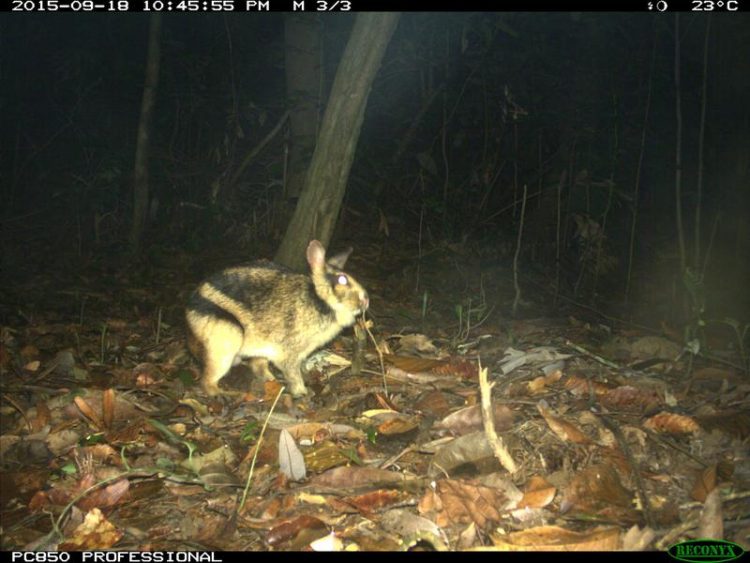Fading stripes in Southeast Asia: First insight into the ecology of an elusive and threatened rabbit

An annamite striped rabbit captured by a camera trap in the Hue Saola Nature Reserve (Vietnam) Leibniz-IZW / WWF-Vietnam CarBi Project / Hue Saola Nature Reserve
The researchers used camera-trapping to study the Annamite striped rabbit in five areas of Vietnam and Laos. Camera traps placed across the landscape showed that although the rabbit occurs in all areas, the species was nowhere common, and in one protected area it appears to be approaching local extinction.
These results show that the intensive poaching in Vietnam and Laos, accomplished by setting wire snares, has clearly impacted striped rabbit populations. However, the fact that it still occurs at all in a region that has experienced such intensive snaring provides hope that, with effective anti-poaching efforts, these populations could recover.
“It is exciting to provide the first insight into such an elusive species,” says Andrew Tilker, PhD student at Leibniz-IZW and an Associate Conservation Scientist at Global Wildlife Conservation.
“Of course, this information is interesting from a scientific perspective, but more importantly it can help inform evidence-driven conservation initiatives. Our results provide exact locations for targeted snare removal efforts. We also establish the first conservation baseline for the species, which can be used to monitor population trends.”
Dr. Ben Rawson, WWF-Vietnam’s Conservation and Program Development Director, hopes that intensive efforts to halt snaring will result in rebounds in the Annamite striped rabbit populations. “With continued snare removal efforts in the Saola Nature Reserves led by WWF and our local partners, we are confident that this remarkable species can thrive.”
One of the most significant findings of this study is that the Annamite striped rabbit occurs in an unprotected forest area in Laos, near a remote village called Ban Palé. The presence of the rabbit in the Palé area – along with other rare and threatened species – further supports ongoing initiatives to grant this area official protected status. The Palé area is under imminent threat from illegal hunting, logging, and gold-mining operations.
Francois Guegan, Conservation Director for WWF-Laos, notes: “We must act now to stop these threats and to provide effective protection to Palé. We have to work together, and we have to act fast. Otherwise we will lose the Annamite striped rabbit and other conservation-priority species from this site.”
“The Annamite striped rabbit is part of what makes the Annamites unique,” says co-author Associate Professor Minh Le from Vietnam National University. “This study shows how fragile the species’ survival is, even in protected areas.” An Nguyen, Field Coordinator for the Leibniz-IZW project, agrees.
“The species is hanging on – but for how much longer? We need to improve law enforcement, stop snaring, and reduce the demand for bush-meat. One organization alone cannot do this. We need to work together – if the Annamite striped rabbit is to survive.”
Andrew Tilker (English)
Department for Ecological Dynamics
Leibniz Institute for Zoo and Wildlife Research (Leibniz-IZW) in the Forschungsverbund Berlin e.V.
Alfred-Kowalke-Straße 17
10315 Berlin
Phone: +49 (0)30 5168722
E-Mail: tilker@izw-berlin.de
Andreas Wilting (English, German)
Department for Ecological Dynamics, Head of the Junior Research Group Biodiversity and Biogeography of Southeast Asia
Leibniz Institute for Zoo and Wildlife Research (Leibniz-IZW) in the Forschungsverbund Berlin e.V.
Alfred-Kowalke-Straße 17
10315 Berlin
Phone: +49 (0)30 5168333
E-Mail: wilting@izw-berlin.de
Tilker A, Nguyen A, Abrams JF, Bhagwat T, Le M, Nguyen TV, Nguyen AT, Niedballa J, Sollmann R, Wilting A (2018): A little-known endemic caught in the South-east Asian extinction crisis: the Annamite striped rabbit Nesolagus timminsi. ORYX. https://doi.org/10.1017/S0030605318000534
Media Contact
More Information:
http://www.fv-berlin.deAll latest news from the category: Ecology, The Environment and Conservation
This complex theme deals primarily with interactions between organisms and the environmental factors that impact them, but to a greater extent between individual inanimate environmental factors.
innovations-report offers informative reports and articles on topics such as climate protection, landscape conservation, ecological systems, wildlife and nature parks and ecosystem efficiency and balance.
Newest articles

First-of-its-kind study uses remote sensing to monitor plastic debris in rivers and lakes
Remote sensing creates a cost-effective solution to monitoring plastic pollution. A first-of-its-kind study from researchers at the University of Minnesota Twin Cities shows how remote sensing can help monitor and…

Laser-based artificial neuron mimics nerve cell functions at lightning speed
With a processing speed a billion times faster than nature, chip-based laser neuron could help advance AI tasks such as pattern recognition and sequence prediction. Researchers have developed a laser-based…

Optimising the processing of plastic waste
Just one look in the yellow bin reveals a colourful jumble of different types of plastic. However, the purer and more uniform plastic waste is, the easier it is to…



